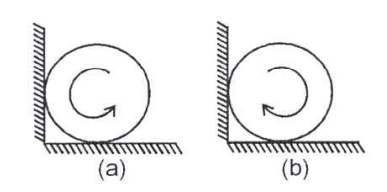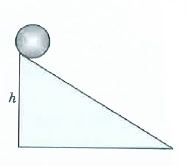A sphere can roll on a surface inclined at an angle θ if the friction coefficient is more than 2/7gtanθ. Suppose the friction coefficient is 1/7gtanθ. If a sphere is released from rest on the incline a it will stay at rest b it will make pure translational motion c it will translate and rotate about the centre d the angular momentum of the sphere about its centre will remain constant.
The correct Answer is:it
c it will translate and rotate about the centreExplanation: Since there is some friction which will produce a torque on the sphere and there is no othe torque to balance it. Hnce the sphere will not stay at rest. Option a is not correct. Due to the torque produced by the friction it will have some rotational motion also. Hence option b is not correct. From the question the friction coefficient is =1/7g.sinθ which is lessthan 2/7g.sinθ {required for rolling only} so it will translate and rotate about the center. Option c is correct. As the sphere go down the inclined plane its angular velocity will get increasing. So the angular momentum of the sphere about its center will continue increasing. Option d is not correct.
Related Solutions
A sphere can roll on a surface inclined at an angle if friction coefficient is more than If a sphere is released from rest on the incline
View SolutionA sphere can roll on a surface inclined at an angle if the friction coefficient is more than . If a sphere is released from rest on the incline
View SolutionA sphere can roll on a surface inclined at an angle if the friction coefficient is more than . If a sphere is released from rest on the incline.
View SolutionA sphere can roll on a surface inclined at an angle if the friction coefficient is more than . Suppose the friction coefficient is , and a sphere is released from rest on the incline,
View SolutionA sphere can roll on a surface inclined at an angle if the friction coefficient is more than . Suppose the friction coefficient is , and a sphere is released from rest on the incline,
View SolutionA sphere can roll on a surface inclined at an angle if the friction coefficient is more than . Suppose the friction coefficient is , and a sphere is released from rest on the incline,
View SolutionA sphere can roll on a surface inclined at an angle if the friction coefficient is more than . If a sphere is relased from rest on the incline
View SolutionA sphere can roll without slipping on a surface inclined at an angle theta if the fiiction coefficient is more than (2/7)g sin theta Suppose the friction coefficient is (l/7)g sin theta If a sphere is released from rest on this incline then which ofthe following are possible situations:
View SolutionA sphere can roll on a surface inclined at an angle , if the friction coefficient . Now suppose the friction coefficient is and the sphere is released from rest on the incline, then
View SolutionA sphere rolls without slipping on an incline of inclination theta . The minimum coefficient of static friction to support pure rolling is to be
View SolutionA sphere rolls without slipping on an incline of inclination theta . The minimum coefficient of static friction to support pure rolling is to be
View SolutionA sphere rolls without slipping on an incline of inclination theta . The minimum coefficient of static friction to support pure rolling is to be
View SolutionA hollow sphere rolls down a rough inclined plane whose angle of inclination is theta , with horizontal. For the hollow sphere to undergo pure rolling, without slipping, the condition is [ mu = coefficient of friction between the hollow sphere and inclined plane]
View SolutionA hollow sphere rolls down a rough inclined plane whose angle of inclination is , with horizontal. For the hollow sphere to undergo pure rolling, without slipping, the condition is [ = coefficient of friction between the hollow sphere and inclined plane]
View SolutionA sphere is placed rotating with its centre initially at rest in a corner as shown in figures (A) and (B). Coefficient of friction between all surfaces and the sphere is 1/3. Find the ratio of the frictional forces by ground in situations (A) and (B)
 View Solution
View SolutionA solid sphere is released from the state of rest on an inclined plane. Mass of the sphere is m and its radius is r. Inclined plane makes an angle with the horizontal. If minimum coefficient of friction required for pure rolling is (n)/(7)tan theta then calculate value of n.
View SolutionSmall sphere of mass m and radius r is kept on fixed inclined rough surface. Surface makes an angle with the horizontal. Initially centre of sphere is at a height h above the horizontal floor. Coefficient of friction between the sphere and surface is u. Sphere is released from the state of rest.

Assume friction is not sufficient to provided pure rolling. Acceleration of the sphere isView SolutionSmall sphere of mass m and radius r is kept on fixed inclined rough surface. Surface makes an angle with the horizontal. Initially centre of sphere is at a height h above the horizontal floor. Coefficient of friction between the sphere and surface is u. Sphere is released from the state of rest. Assume that friction is sufficiet enough to provide pure rolling. Speed of the sphere as it reaches the bottom is
View SolutionA sphere of mass m rolls without slipping on an inclined plane of inclination . Find the linear acceleration of the sphere and the force of friction acting on it. What should be the minimum coefficient of static friction to support pure rolling?
View SolutionA solid sphere is in pure rolling motion on an inclined surface having inclination
View Solution
